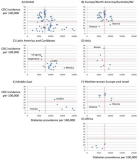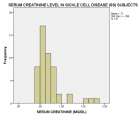Abstract
Editorial
Unveiling the gut virome in human health and diseases
Tao Zuo*
Published: 19 January, 2018 | Volume 2 - Issue 1 | Pages: 001-003
Due to the advances in high-throughput sequencing technologies, the gut vriome is increasingly being perceived as one important component of the gut microbiome, where the number of viral biological entities is believed to far outcompetes that of the bacterial populations [1,2]. The human virome are primarily composed of bacteriophages, animal-cell viruses, endogenous retroviruses and viruses causing persistent and latent infections. Collectively they contains a more diverse genetic entity than the gut bacteria [3,4]. While the composition of them in the gut is precipitately being revealed, their roles in human health remain largely unexplored. It is undeniable that certain gut viruses are deleterious to human health. Interestingly, enteric viruses however, in some cases, can recapitulate the beneficial effects of commensal bacteria through different mechanisms, including modulating the innate and adaptive immunity of the host [5-7].
Read Full Article HTML DOI: 10.29328/journal.ijcv.1001002 Cite this Article Read Full Article PDF
References
- Virgin HW. The Virome in Mammalian Physiology and Disease. Cell. 2014; 157: 142-150. Ref.: https://goo.gl/YRtWsi
- Carding SR, Davis N, Hoyles L. Review article: the human intestinal virome in health and disease. Aliment Pharmacol Ther. 2017; 46: 800-815. Ref.: https://goo.gl/k1dtxk
- Ogilvie LA, Jones BV. The human gut virome: a multifaceted majority. Frontiers in Microbiology. 2015; 6: 918. Ref.: https://goo.gl/6imc97
- Lecuit M, Eloit M. The human virome: new tools and concepts. Trends in Microbiology. 2013; 21: 510-515. Ref.: https://goo.gl/jf55PZ
- Yang JY, Min-Soo Kim, Eugene Kim, JH Cheon, Yong-Soo Lee, et al. Enteric Viruses Ameliorate Gut Inflammation via Toll-like Receptor 3 and Toll-like Receptor 7-Mediated Interferon-beta Production. Immunity. 2016; 44: 889-900. Ref.: https://goo.gl/k5iWbW
- Kernbauer E, Ding Y, Cadwell K. An enteric virus can replace the beneficial function of commensal bacteria. Nature. 2014; 516: 94-98. Ref.: https://goo.gl/kXfpXS
- Duerkop BA, Hooper LV. Resident viruses and their interactions with the immune system. Nature Immunology. 2013; 14: 654-659. Ref.: https://goo.gl/H9DVVk
- Minot S, Alexandra Bryson, Christel Chehoud, Gary D Wu, James D Lewis, et al. Rapid evolution of the human gut virome. Proceedings of the National Academy of Sciences of the United States of America. 2013; 110: 12450-12455. Ref.: https://goo.gl/JcxFHs
- Minot S, Grunberg S, Wu GD, Lewis JD, Bushman FD. Hypervariable loci in the human gut virome. Proceedings of the National Academy of Sciences of the United States of America. 2012; 109: 3962-3966. Ref.: https://goo.gl/jCKA5j
- Alejandro Reyes, Matthew Haynes, Nicole Hanson, Florent E Angly, Andrew C Heath, et al. Viruses in the faecal microbiota of monozygotic twins and their mothers. Nature. 2010; 466: 334-338. Ref.: https://goo.gl/Pzwc5G
- Alison S Waller, Takuji Yamada, David M Kristensen, Jens Roat Kultima, Shinichi Sunagawa, et al. Classification and quantification of bacteriophage taxa in human gut metagenomes. Isme Journal. 2014; 8: 1391-1402. Ref.: https://goo.gl/pB4BUU
- Jeremy J Barra, Rita Auroa, Mike Furlana, Katrine L Whitesona, Marcella L Erb, et al. Bacteriophage adhering to mucus provide a non-host-derived immunity. Proceedings of the National Academy of Sciences of the United States of America. 2013; 110: 10771-10776. Ref.: https://goo.gl/jjGzqY
- Tao Zuo, Sunny H Wong, Long Yan K Lam, Rashid Lui, Kitty Cheung, et al. Bacteriophage Transfer during Fecal Microbiota Transplantation Is Associated with Treatment Response in Clostridium Difficile Infection. Gastroenterology. 2017. 152: 140-141. Ref.: https://goo.gl/UBx9w8
- Torres-Barceló C, Hochberg ME. Evolutionary rationale for phages as complements of antibiotics. Trends in microbiology. 2016; 24: 249-256. Ref.: https://goo.gl/XDeVVo
- Jason M Norman, Scott A Handley, Megan T Baldridge, Lindsay Droit, Catherine Y Liu, et al. Disease-Specific Alterations in the Enteric Virome in Inflammatory Bowel Disease. Cell. 2015; 160: 447-460. Ref.: https://goo.gl/nkvXH3
- Tao Zuo, Sunny H Wong, Kelvin Lam, Rashid Lui, Kitty Cheung, et al. Bacteriophage transfer during faecal microbiota transplantation in Clostridium difficile infection is associated with treatment outcome. Gut microbiota. 2017. Ref.: https://goo.gl/HwGQcN
- Brussow H, Canchaya C, Hardt WD. Phages and the evolution of bacterial pathogens: From genomic rearrangements to lysogenic conversion. Microbiology and Molecular Biology Reviews. 2004; 68: 560-602. Ref.: https://goo.gl/bKXZ7r
- Reyes A, Wu M, Mc Nulty NP, Rohwer FL, Gordon JI. Gnotobiotic mouse model of phage-bacterial host dynamics in the human gut. Proceedings of the National Academy of Sciences of the United States of America. 2013; 110: 20236-20241. Ref.: https://goo.gl/oNsj8Z
- Zhang YF, LeJeune JT. Transduction of bla(CMY-2), tet(A), and tet(B) from Salmonella enterica subspecies enterica serovar Heidelberg to S-Typhimurium. Veterinary Microbiology. 2008; 129: 418-425. Ref.: https://goo.gl/7NRAUM
- Elisa Maiques, Carles Úbeda, Susana Campoy, Noelia Salvador, Íñigo Lasa, et al. beta-lactam antibiotics induce the SOS response and horizontal transfer of virulence factors in Staphylococcus aureus. Journal of Bacteriology. 2006; 188: 2726-2729. Ref.: https://goo.gl/5SgY4m
- Kim MS, Bae JW. Spatial disturbances in altered mucosal and luminal gut viromes of diet-induced obese mice. Environmental Microbiology. 2016; 18: 1498-1510. Ref.: https://goo.gl/xFtXJB
- Samuel Minot, Rohini Sinha, Jun Chen, Hongzhe Li, Sue A Keilbaugh, et al. The human gut virome: Inter-individual variation and dynamic response to diet. Genome Research. 2011; 21: 1616-1625. Ref.: https://goo.gl/kyvFBW
- Efrem S Lim, Yanjiao Zhou, Guoyan Zhao, Irma K Bauer, Lindsay Droit, et al. Early life dynamics of the human gut virome and bacterial microbiome in infants. Nature Medicine. 2015; 21: 1228-1234. Ref.: https://goo.gl/g6enGj
Similar Articles
-
Antiviral activity of Eucalyptus camaldulensis leaves ethanolic extract on herpes viruses infectionMahmoud Huleihel*,Aya Abu-Jafar. Antiviral activity of Eucalyptus camaldulensis leaves ethanolic extract on herpes viruses infection. . 2017 doi: 10.29328/journal.ijcv.1001001; 1: 001-009
-
Unveiling the gut virome in human health and diseasesTao Zuo*. Unveiling the gut virome in human health and diseases. . 2018 doi: 10.29328/journal.ijcv.1001002; 2: 001-003
-
Determine seroprevalence and associated risk factors of HBV infection among pregnant women and it relationship with blood transfusion at Hargeisa Group Hospital, Hargeisa, SomalilandAbdullah Al-Mamari*. Determine seroprevalence and associated risk factors of HBV infection among pregnant women and it relationship with blood transfusion at Hargeisa Group Hospital, Hargeisa, Somaliland. . 2019 doi: 10.29328/journal.ijcv.1001003; 3: 001-009
-
A model of the 2014 Ebola virus: Evidence of West AfricaNadhem Selmi*. A model of the 2014 Ebola virus: Evidence of West Africa. . 2019 doi: 10.29328/journal.ijcv.1001004; 3: 010-015
-
Frequency of cytomegalovirus infection in children with Nephrotic SyndromeDoaa Mohammed Youssef*,Mohammed Hassan Mohammed,Eman Mohammed EL-Behaidy,Asmaa EL-Sayed Abo-warda1. Frequency of cytomegalovirus infection in children with Nephrotic Syndrome. . 2019 doi: 10.29328/journal.ijcv.1001005; 3: 016-020
-
Low sensitivity of the careHPV™ Assay for detection of Oncogenic Human Papillomavirus in cervical samples from HIV-infected and HIV-uninfected Kenyan womenBrown DR*,Titus M,Ermel A,Moormann A,Cu-Uvin S,Orang’o O,Tonui P,Chelimo K,Rosen B,Itsura P,Muthoka K,Loehrer P,Ong’echa JM. Low sensitivity of the careHPV™ Assay for detection of Oncogenic Human Papillomavirus in cervical samples from HIV-infected and HIV-uninfected Kenyan women. . 2020 doi: 10.29328/journal.ijcv.1001006; 4: 001-005
-
Rubella infection: Advances and challenges in the diagnosis and prevention of Congenital Rubella SyndromeAmélia Nkutxi Vueba*,Maria do Céu Sousa. Rubella infection: Advances and challenges in the diagnosis and prevention of Congenital Rubella Syndrome. . 2020 doi: 10.29328/journal.ijcv.1001007; 4: 006-013
-
Pseudoephedrine protects mice from infection of H1N1 virusZhongping Wu*,Li Deng,Chengzhi Chu,Xiaoyin Chen*. Pseudoephedrine protects mice from infection of H1N1 virus. . 2020 doi: 10.29328/journal.ijcv.1001008; 4: 014-020
-
Hypothesis about pathogenic action of Sars-COV-2Del Prete Salvatore*,Marasco Daniela,Sabetta Rosalaura. Hypothesis about pathogenic action of Sars-COV-2. . 2020 doi: 10.29328/journal.ijcv.1001009; 4: 021-022
-
Vitamin D produce antibodies in pandemic response to gripal viruses? A critical analysisEliza Miranda Ramos*,Francisco José Mendes dos Reis,Hugo Vieira Ramos,Igor Domingos de Souza,Liliane de Mello Santos Bochenek,Alessandro Carvalho da Fonseca,Valter Aragão do Nascimento. Vitamin D produce antibodies in pandemic response to gripal viruses? A critical analysis. . 2020 doi: 10.29328/journal.ijcv.1001010; 4: 023-026
Recently Viewed
-
About Efficiency of High-order Harmonic Generation in Attosecond PhysicsAng-Yang Yu*. About Efficiency of High-order Harmonic Generation in Attosecond Physics. Int J Clin Virol. 2024: doi: 10.29328/journal.ijcv.1001061; 8: 045-047
-
Success, Survival and Prognostic Factors in Implant Prosthesis: Experimental StudyEpifania Ettore*, Pietrantonio Maria, Christian Nunziata, Ausiello Pietro. Success, Survival and Prognostic Factors in Implant Prosthesis: Experimental Study. J Oral Health Craniofac Sci. 2023: doi: 10.29328/journal.johcs.1001045; 8: 024-028
-
Agriculture High-Quality Development and NutritionZhongsheng Guo*. Agriculture High-Quality Development and Nutrition. Arch Food Nutr Sci. 2024: doi: 10.29328/journal.afns.1001060; 8: 038-040
-
A Low-cost High-throughput Targeted Sequencing for the Accurate Detection of Respiratory Tract PathogenChangyan Ju, Chengbosen Zhou, Zhezhi Deng, Jingwei Gao, Weizhao Jiang, Hanbing Zeng, Haiwei Huang, Yongxiang Duan, David X Deng*. A Low-cost High-throughput Targeted Sequencing for the Accurate Detection of Respiratory Tract Pathogen. Int J Clin Virol. 2024: doi: 10.29328/journal.ijcv.1001056; 8: 001-007
-
A Comparative Study of Metoprolol and Amlodipine on Mortality, Disability and Complication in Acute StrokeJayantee Kalita*,Dhiraj Kumar,Nagendra B Gutti,Sandeep K Gupta,Anadi Mishra,Vivek Singh. A Comparative Study of Metoprolol and Amlodipine on Mortality, Disability and Complication in Acute Stroke. J Neurosci Neurol Disord. 2025: doi: 10.29328/journal.jnnd.1001108; 9: 039-045
Most Viewed
-
Evaluation of Biostimulants Based on Recovered Protein Hydrolysates from Animal By-products as Plant Growth EnhancersH Pérez-Aguilar*, M Lacruz-Asaro, F Arán-Ais. Evaluation of Biostimulants Based on Recovered Protein Hydrolysates from Animal By-products as Plant Growth Enhancers. J Plant Sci Phytopathol. 2023 doi: 10.29328/journal.jpsp.1001104; 7: 042-047
-
Sinonasal Myxoma Extending into the Orbit in a 4-Year Old: A Case PresentationJulian A Purrinos*, Ramzi Younis. Sinonasal Myxoma Extending into the Orbit in a 4-Year Old: A Case Presentation. Arch Case Rep. 2024 doi: 10.29328/journal.acr.1001099; 8: 075-077
-
Feasibility study of magnetic sensing for detecting single-neuron action potentialsDenis Tonini,Kai Wu,Renata Saha,Jian-Ping Wang*. Feasibility study of magnetic sensing for detecting single-neuron action potentials. Ann Biomed Sci Eng. 2022 doi: 10.29328/journal.abse.1001018; 6: 019-029
-
Pediatric Dysgerminoma: Unveiling a Rare Ovarian TumorFaten Limaiem*, Khalil Saffar, Ahmed Halouani. Pediatric Dysgerminoma: Unveiling a Rare Ovarian Tumor. Arch Case Rep. 2024 doi: 10.29328/journal.acr.1001087; 8: 010-013
-
Physical activity can change the physiological and psychological circumstances during COVID-19 pandemic: A narrative reviewKhashayar Maroufi*. Physical activity can change the physiological and psychological circumstances during COVID-19 pandemic: A narrative review. J Sports Med Ther. 2021 doi: 10.29328/journal.jsmt.1001051; 6: 001-007

HSPI: We're glad you're here. Please click "create a new Query" if you are a new visitor to our website and need further information from us.
If you are already a member of our network and need to keep track of any developments regarding a question you have already submitted, click "take me to my Query."


















































































































































